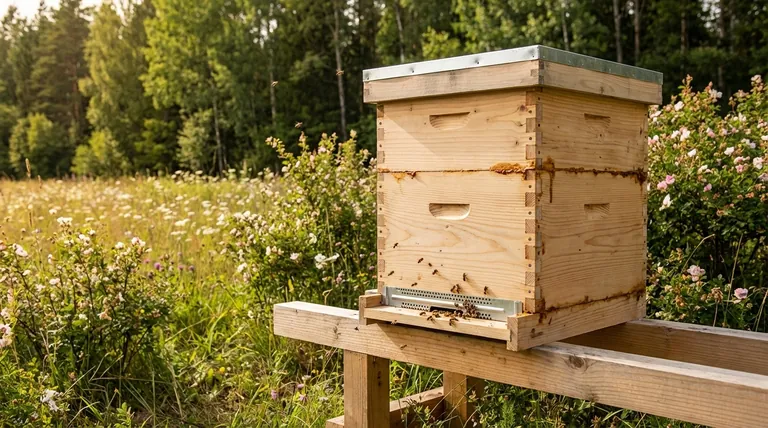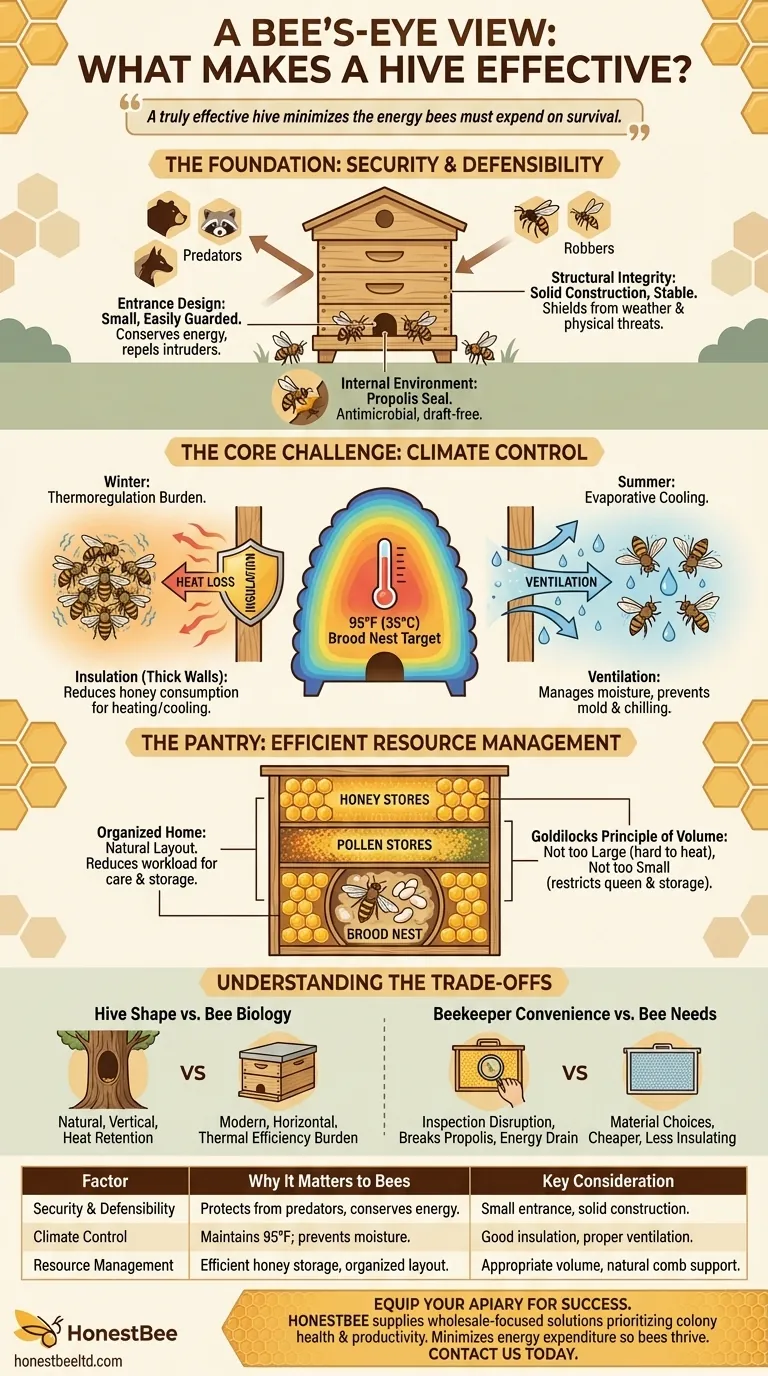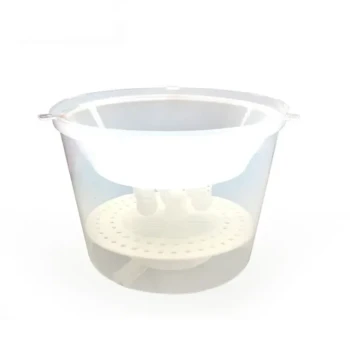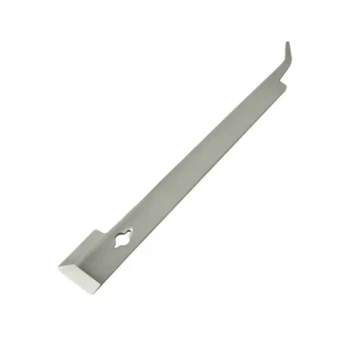From a bee's perspective, an effective hive is not just a box but a fortress, a climate-controlled nursery, and a well-stocked pantry. Its success is determined by how well its design supports the colony's three core survival imperatives: regulating internal temperature, defending against threats, and efficiently storing food for winter.
A truly effective hive minimizes the energy bees must expend on survival. The less work they do fighting heat, cold, and moisture, the more resources they can dedicate to raising brood and gathering the stores needed to endure the next season.

The Foundation: Security and Defensibility
A colony's first priority is safety. An effective hive provides a secure structure that the bees can successfully defend from predators, robbers from other hives, and pests.
Entrance Design is Critical
A small, easily guarded entrance is a significant advantage. It allows a few guard bees to effectively repel intruders, conserving the colony's energy and protecting its precious resources.
Structural Integrity
The hive must shield the colony from wind, rain, and physical threats like raccoons or bears. Solid construction and stable placement are non-negotiable for the bees' sense of security.
Internal Environment
Bees use a substance called propolis (a resinous mixture) to seal cracks and smooth interior surfaces. A hive made from materials that encourage this, like rough-hewn wood, helps the bees create an antimicrobial and draft-free home.
The Core Challenge: Climate Control
Bees are masters of thermoregulation, but the hive's design plays a massive role in how much energy this process consumes. The colony's goal is to maintain a stable brood nest temperature of around 95°F (35°C).
The Burden of Thermoregulation
In winter, bees form a tight cluster and shiver their flight muscles to generate heat. In summer, they fan their wings and use evaporative cooling to prevent overheating. Both are incredibly energy-intensive.
The Role of Insulation
A hive with good insulating properties (like thick wooden walls) acts as a buffer against external temperature swings. This drastically reduces the amount of honey the bees must consume just to stay warm in winter or cool in summer.
Managing Moisture with Ventilation
A colony releases a significant amount of water vapor through respiration. Without proper ventilation, this moisture condenses on cold surfaces, leading to chilling and mold. An effective hive allows this moist air to escape without creating a draft.
The Pantry: Efficient Resource Management
A hive's internal structure must function as a logical and efficient space for raising young and storing food. Honey isn't a surplus product for bees; it is their sole source of food for surviving the winter.
Organizing the Home
Bees naturally organize their hive with the brood nest (where the queen lays eggs) at the bottom, surrounded by a band of pollen, and with honey stores above and to the sides. A hive that facilitates this natural layout reduces the colony's workload.
The Goldilocks Principle of Volume
A hive that is too large is difficult to heat in winter and defend year-round. A hive that is too small restricts the queen's laying space and limits the amount of honey the colony can store, jeopardizing its winter survival.
Understanding the Trade-offs
Many modern hive designs prioritize the beekeeper's convenience over the bees' natural preferences. Understanding this conflict is key to becoming a better steward of your colonies.
Hive Shape vs. Bee Biology
Bees in nature often build their comb in a tall, vertical cavity like a hollow tree. This shape helps with heat retention and natural ventilation. Many modern, horizontal hives disrupt this thermal efficiency, placing a greater energy burden on the colony.
Inspection and Disruption
While necessary for the beekeeper, every hive inspection breaks the propolis seals the bees have carefully made. This forces them to expend significant energy and resources to repair their home's defenses and climate seals.
Material Choices
Non-traditional materials like plastic may be cheaper and easier to clean for the beekeeper, but they often lack the insulating and moisture-wicking properties of natural wood, forcing the bees to work harder to manage their environment.
Making the Right Choice for Your Goal
Selecting a hive requires balancing the needs of the bees with your own goals as a beekeeper.
- If your primary focus is maximizing colony health and overwintering success: Prioritize hives made from thick, insulating materials (like wood) with designs that promote good ventilation and offer an appropriate volume for your climate.
- If your primary focus is ease of management and honey harvesting: Standard Langstroth hives are the industry benchmark for a reason, but be mindful of adding insulation and ensuring proper ventilation to support the colony's energy needs.
- If your primary focus is mimicking a more natural environment: Consider Top Bar or Warre hives, which more closely resemble a hollow log, but be prepared for a different style of management and potentially smaller honey harvests.
By understanding what makes a home effective from the bees' point of view, you can make choices that support a resilient, healthy, and productive colony.
Summary Table:
| Factor | Why It Matters to Bees | Key Consideration |
|---|---|---|
| Security & Defensibility | Protects from predators and pests, conserving energy. | Small, easily guarded entrance; solid construction. |
| Climate Control | Maintains brood nest temperature (95°F/35°C); prevents moisture. | Good insulation; proper ventilation. |
| Resource Management | Efficiently stores honey for winter; organizes brood and pollen. | Appropriate hive volume; facilitates natural comb layout. |
Equip your apiary with hives designed for bee success. At HONESTBEE, we supply commercial apiaries and beekeeping equipment distributors with wholesale-focused solutions that prioritize colony health and productivity. Our durable, well-designed equipment helps minimize the energy your bees expend on survival, so they can focus on what they do best. Contact us today to discuss how our supplies can support your resilient, thriving colonies.
Get in Touch with Our Wholesale Team
Visual Guide

Related Products
- Langstroth Bee Hives Bee Keeping Box for Beginners Beekeeping
- Long Langstroth Style Horizontal Top Bar Hive for Wholesale
- HONESTBEE Advanced Ergonomic Stainless Steel Hive Tool for Beekeeping
- Wholesales Dadant Size Wooden Bee Hives for Beekeeping
- Professional Dual-End Stainless Steel Hive Tool for Beekeeping
People Also Ask
- What basic equipment is needed to start beekeeping? Your Essential Guide to a Confident Start
- What are the key features of the Langstroth beehive? A Guide to the Standard for Modern Beekeeping
- Why are Langstroth hives recommended for beginners? Unmatched Support & Standardization
- What are the different types of beehive boxes available? Choose the Right Hive for Your Apiary
- How does the orientation of the hive sides benefit comb construction? Ensure Straight, Movable Combs for Easier Hive Management



















